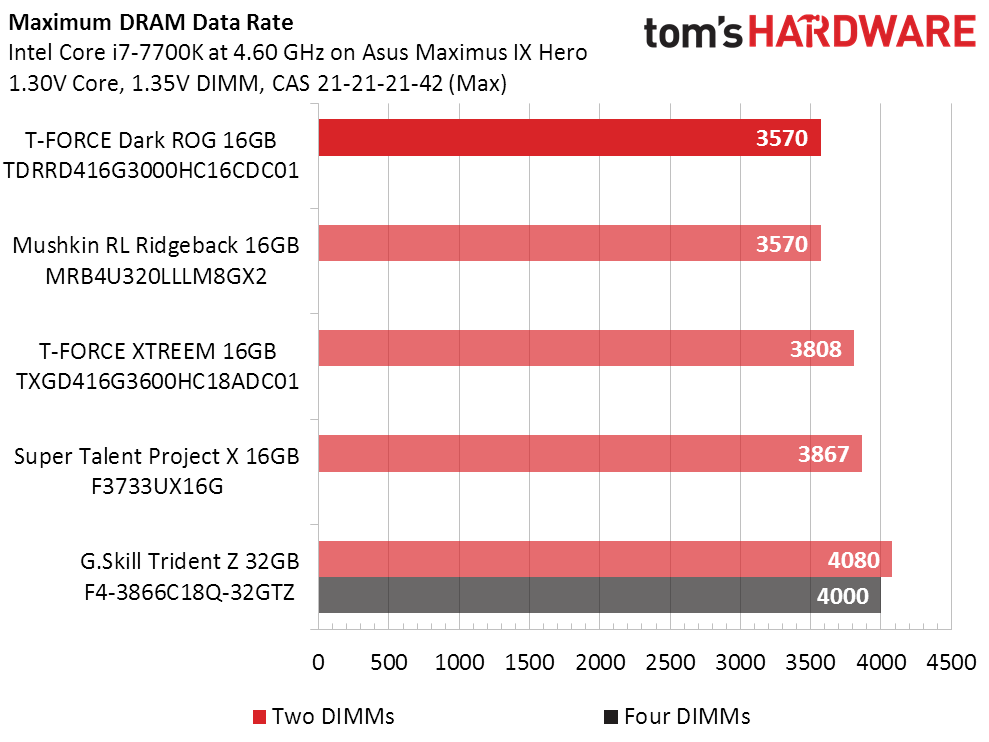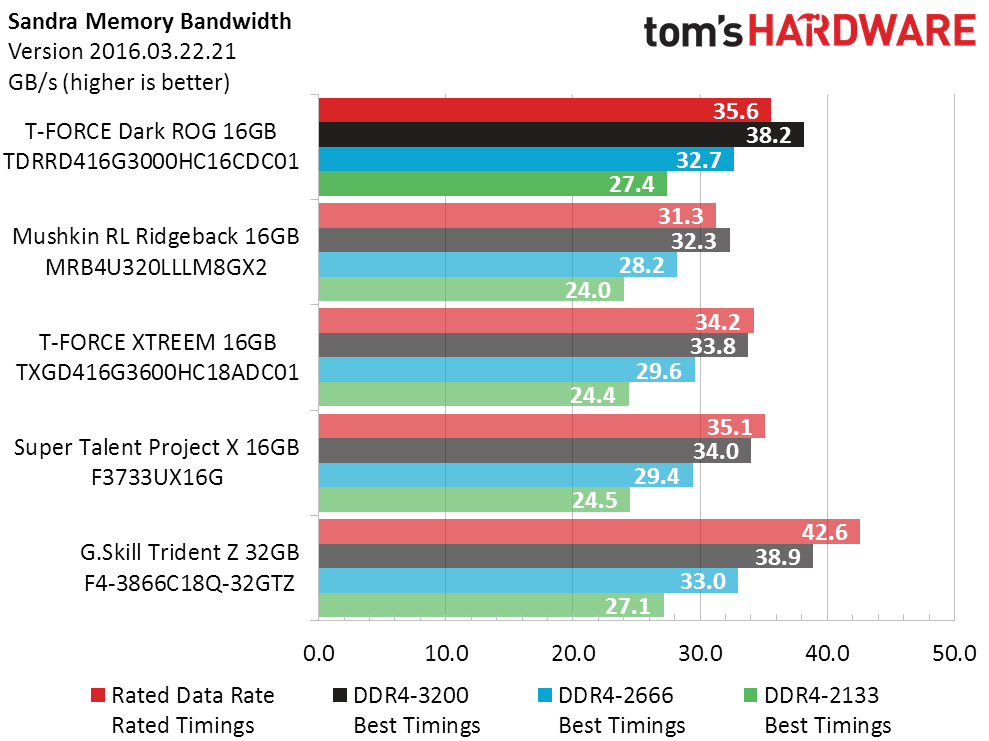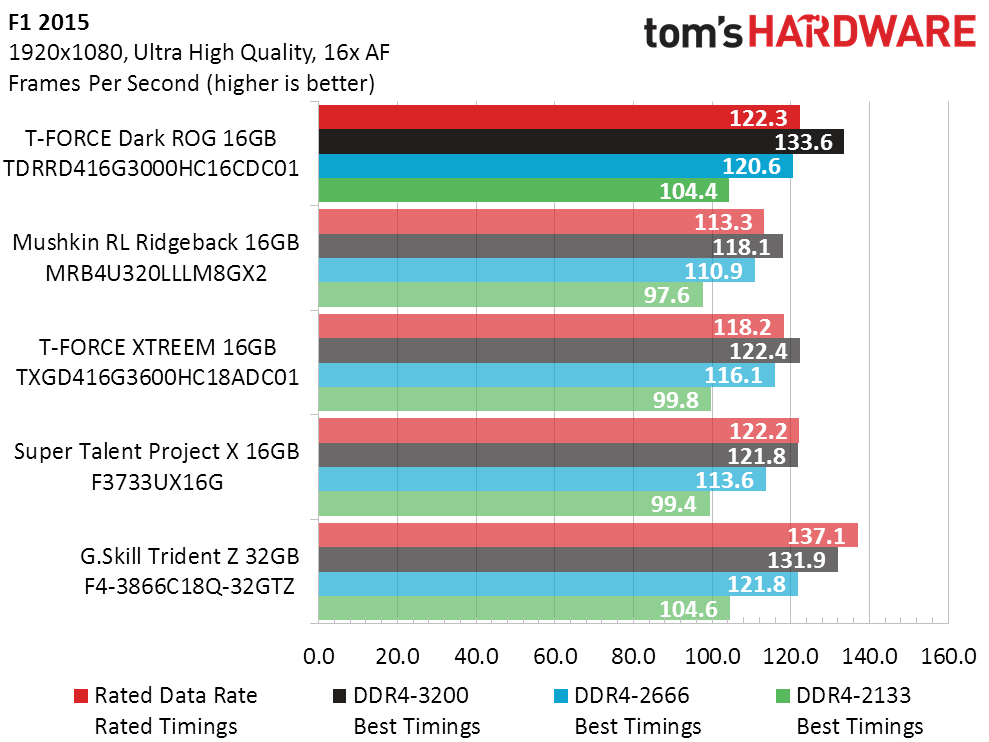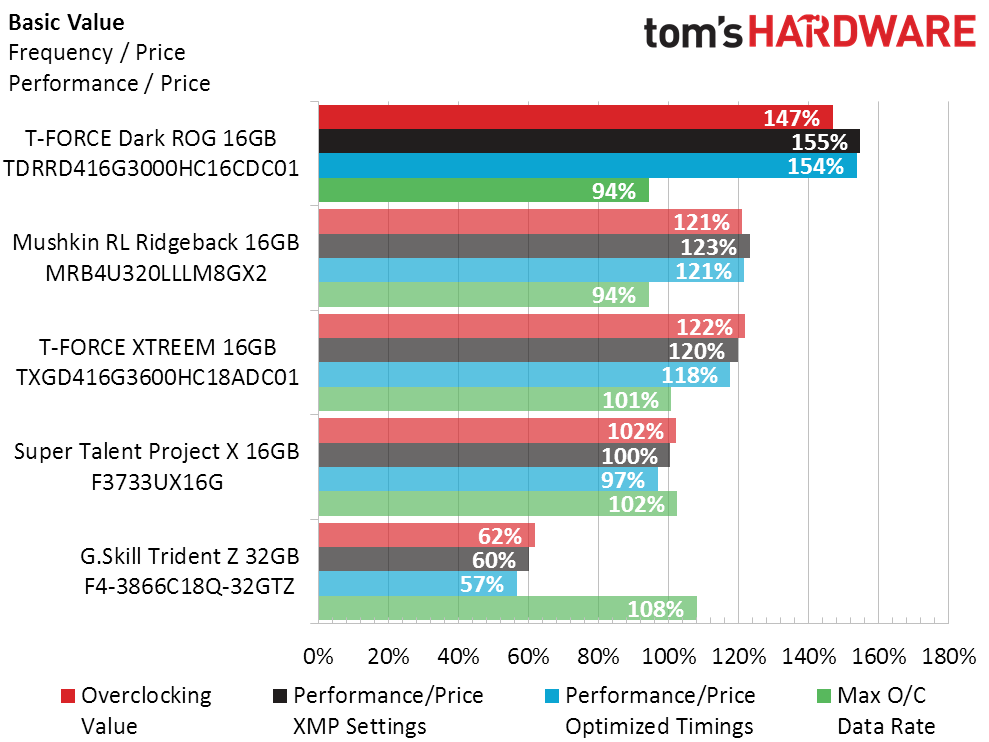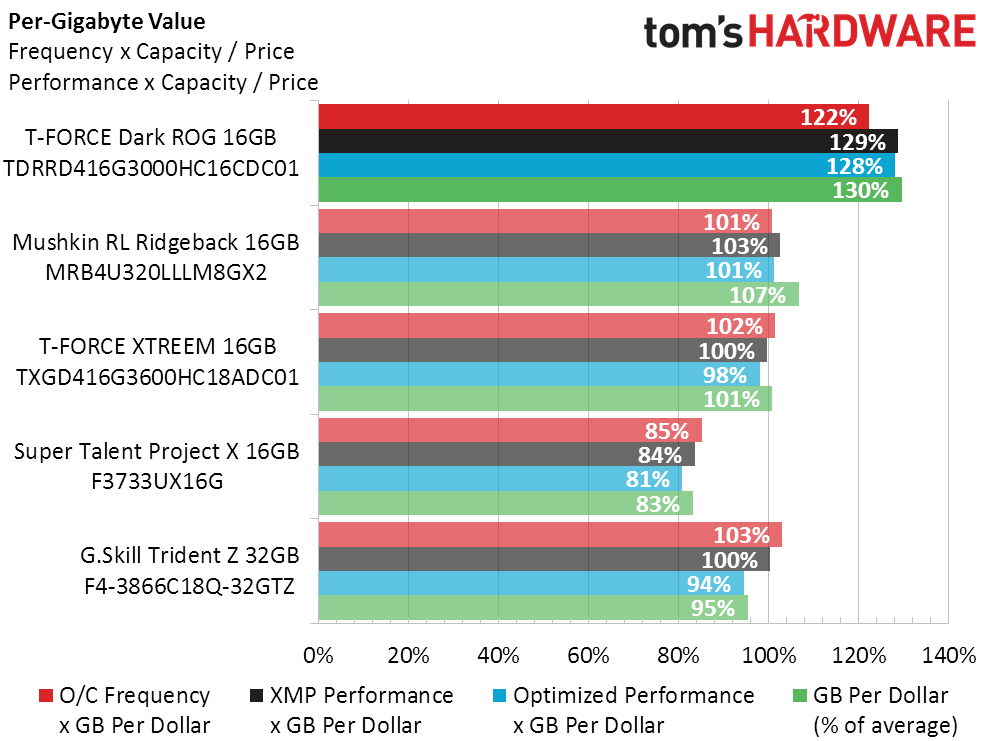Team Group Dark ROG 16GB DDR4-3000 Review
Why you can trust Tom's Hardware
Benchmark Results & Final Analysis
While overclocking can be severely limited by processor or motherboard selection, nearly all tunable platforms can be tweaked for enhanced timings. Understanding that less latency produces more performance, here’s how low each kit could go without losing stability.
Lowest Stable Timings at 1.35V (Max) on Asus Maximus IX Hero (BIOS 0801)
| Memory Kit | DDR4-3200 | DDR4-2666 | DDR4-2133 |
|---|---|---|---|
| T-FORCE Dark ROG 16GB (TDRRD416G3000HC16CDC01) | 16-17-17-34 (1T) | 13-14-14-28 (1T) | 11-12-12-28 (1T) |
| Mushkin RL Ridgeback 16GB (MRB4U320LLLM8GX2) | 18-19-19-38 (1T) | 15-16-16-32 (1T) | 12-13-13-28 (1T) |
| T-FORCE XTREEM 16GB (TXGD416G3600HC18ADC01) | 14-15-15-30 (1T) | 12-12-12-28 (1T) | 11-11-11-28 (1T) |
| Super Talent Project X 16GB (F3733UX16G) | 14-14-14-28 (1T) | 12-12-12-28 (1T) | 10-10-10-28 (1T) |
| G.Skill Trident Z 32GB (F4-3866C18Q-32GTZ) | 14-15-15-30 (1T) | 12-12-12-28 (1T) | 10-11-11-28 (1T) |
The T-Force Dark ROG memory doesn’t have much flexibility for improved timings, yet still gets ahead of the next-fastest rated set, the Redline Ridgeback.
The T-Force Dark ROG modules also have a relatively low frequency ceiling, though they did start out with a lower rating. Note that the Trident Z is a four-module set, and that all four sets have an 8GB per-module capacity.
Sandra Memory Bandwidth shows the performance benefit of having four total ranks of RAM. The T-Force Dark ROG modules are dual-rank, whereas the Trident Z set achieves four ranks by having four single-rank DIMMs.
Additional memory banks—that is, ranks—impart a slight latency penalty. While the Trident Z set is able to overcome some of that penalty by having a great combination of frequency and timings, the dual-rank T-Force Dark ROG DIMMs have similar total latency to the more conservatively-timed Redline Ridgeback single-rank DIMMs
Fixing the graphics bottleneck of F1 2015 is as easy as using a faster graphics card. With that solved, fixing the CPU bottleneck is as easy as overclocking the CPU. That leaves the memory bottleneck, wherein the dual-rank T-Force Dark ROG modules beat everything except the four-DIMM Trident-Z set.
Get Tom's Hardware's best news and in-depth reviews, straight to your inbox.
Metro Last Light Redux sometimes shows small performance differences when testing big memory changes. These sets are really too close to each other to make the chart stand out, though we can see that for all sets, the DDR4-2133 setting trails slightly. It also appears to be impacted more by total (timed) latency than by bandwidth.
Blender has also appeared to benefit from latency reduction, but only when big changes are made. Once again we see all four modules too closely packed to produce noticeable gains.
Boosted slightly by the bandwidth advantage of four ranks on the Kaby Lake CPU’s memory controller, and held back slightly by the extra time it takes to address additional ranks, T-Force Dark ROG performance is a mixed bag in 7-Zip. It beats only one competitor at rated (XMP) settings, two competitors at DDR4-3200 with the tightest stable timings, three competitors at DDR4-2666, and all four competitors at optimized DDR4-2133 settings.
Even though it’s not a budget set, T-Force Dark ROG modules are still cheaper than higher data-rate-rated rivals. In some instances, these also perform better. At the bottom we see the Trident-Z, which has twice as many modules and twice the total capacity.
Comparing all four value ratings to capacity gives us a fairer way to include the Trident-Z kit. T-Force Dark ROG is still the winner in performance-per-price, even after raising up that 32GB competitor in this capacity-adjusted chart.
It would be easy at this point to recommend T-Force Dark ROG memory to buyers seeking improved performance and good value through the Skylake and Kaby Lake memory controller’s preference for four ranks of RAM. Of course, you can also get four ranks by installing four single-rank modules, or by using someone else’s dual-rank modules. And, if you were shooting for more capacity, you’ll also find a plethora of dual-rank 16GB modules packed into 32GB two-DIMM sets. Yet 16GB is the current market sweet spot, and many builders will only ever use two DIMMs on their current systems. Team Group reaches this market perfectly with its T-Force Dark ROG 16GB DDR4-3000 kit.
MORE: Best Memory
MORE: DDR DRAM FAQs And Troubleshooting Guide
MORE: All Memory Content
-
rhysiam Thanks for the review. Given the decent scaling we've seen from Ryzen CPUs with faster RAM, and Ryzen's somewhat unpredictable relationship with fast RAM kits, would Tom's HW consider a bit of Ryzen RAM Round Up? Throw a bunch of different RAM kits into a couple of Ryzen CPU + Mobo combinations to see how far you can get them while maintaining stability?Reply
I think plenty of people are on the lookout for reasonably priced kits which might get to 2933/3200Mhz (or even higher?) and a round up of a few kits you have on hand could be interesting and really helpful. -
Crashman Reply
TBH I don't even have any Ryzen hardware. The "Ryzen board" guy is considering doing an article, but he's backlogged with more board reviews. You'd be looking at another Ryzen deep-dive rather than a regular memory review, since I actually need Kaby Lake to get some of the faster memory sets up to full speed.19600650 said:Thanks for the review. Given the decent scaling we've seen from Ryzen CPUs with faster RAM, and Ryzen's somewhat unpredictable relationship with fast RAM kits, would Tom's HW consider a bit of Ryzen RAM Round Up? Throw a bunch of different RAM kits into a couple of Ryzen CPU + Mobo combinations to see how far you can get them while maintaining stability?
I think plenty of people are on the lookout for reasonably priced kits which might get to 2933/3200Mhz (or even higher?) and a round up of a few kits you have on hand could be interesting and really helpful.
-
winwiz I understand you need Kaby Lake to test the fast memory at full speed, but a Ryzen memory comparison would be so much more interestingReply
So please donate your Kaby Lake system to a second hand shop and get a Ryzen setup :-) -
bluzbrother I only half believe the excuses for DDR4 prices spiking, and supposedly will be on the ryze throughout 2017 into next year. I think Ryzen, especially the 5 series, is a big part of the prices shooting up. In this moment, I really don't see the value of these tests being done on an Intel platform... not to say there aren't people buying Intel, it's just that Ryzen is the more finicky platform right now, and people want the best for their money. (I definitely was not interested in paying $150+ for 16GB of RAM). I was very curious about this RAM, since it is one of the more reasonably priced brands.Reply
